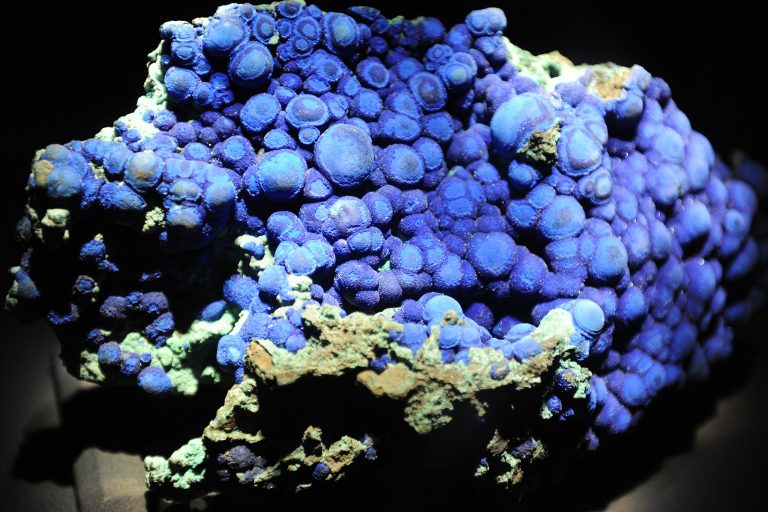Azurite (Lapis Linguis) is an ancient stone with a rich history. It is a rare mineral that is characterized by its stunning twilight blue hue.
Azurite typically occurs as tiny prismatic, tabular, or equidimensional crystals that are striated. Some other forms are large crystalline clusters with a crusty surface and radiating fibers. The stone can be found in many areas of the world from Arizona to Zambia, with Europe, Australia, and China in between.
Cousins
Lapis is the Latin word for stone. Lapis Linguis (Azurite) and its cousin Lapis Lazuli (Lazurite) are both blue stones associated with the azure color, which falls between cyan and blue on the color chart.
Azurite’s copper silicate is formed by the weathering of copper ore deposits, and its chemical composition is Cu3(CO3)2(OH)2. Azurite is almost always found with or near the green mineral Malachite, another copper carbonate hydroxide mineral. Its name originates from the Greek word Lalaku, meaning mallow plant, azurite is often pseudomorphically replaced by Malachite.
Uses
Due to its softness, which rates between 3.5 to 4.0. on the Mohs hardness scale, azurite is not suitable for use as fine jewelry. It is sometimes shaped into polished cabochon beads, however.
Success
You are now signed up for our newsletter
Success
Check your email to complete sign up
This stone is delicate, fades in the sunshine, and becomes permanently blackened by heat. Gradual heating, however, creates a deeper blue hue which is used as a pigment in Japanese painting.
Azurite is believed to clear the mind and is often referred to as “a clear sky over a desert in winter.”

Culture and History
Pliny the Elder, Roman author, naturalist, and natural philosopher, named the gem “kuanos,” meaning “deep blue” in Greek, dedicating it to “all things blue and green.”
Until the early 19th century, azurite was known as Chessylite after the Chessy Mines, where it was mined in France. From the 15th to the middle of the 17th century, azurite was the most widely used blue pigment in European painting. Crushed azurite was also very popular among the ancient Egyptian artisans. In the East, azurite pigment appeared in the Ming and Song Dynasty on walls and in cave paintings in China.
Jiangyin Temple, known as Tutang Buddha Temple, is situated in Tutang Village, Shanxi Province. First built during the Northern Qi dynasty, and later rebuilt in 1205 AD during the Jin Dynasty, the temple hosts a statue of Bodhisattva Avalokitesvara, whose kasaya was painted with a mineral pigment identified by scientists as Azurite.
Cultural significance
Native American tribes regarded Azurite as a holy stone and considered it highly powerful in healing. Associated with enigmatic spiritual qualities, it was formerly worn as an amulet in certain Native American tribes to aid the user in communicating with a spirit guide. The Zuni tribe used it in conjunction with Alabaster.
Legends claim that azurite was widely used in Atlantis and in ancient Egypt, where it was revered as a spiritual aid that helped high priests become more conscious of God. The Egyptian temple priests believed that painting the protecting eye of the god Horus with azurite pigment on their foreheads enhanced their physic abilities.
The Mayans promoted the transmission of information, knowledge, and wisdom with the help of azurite, while ancient Romans valued azurite for its medicinal properties.
Vibrational energy
Edgar Cayce, the American prophetic seer, reportedly sought out azurite to have “Visionary Experiences” that would guide him in his life’s work. “The vibratory essence of what he [Edgar Cayce] termed the ‘Singing Stones’ (azurite) allowed him to regain understanding during a great life crisis. He was guided to specific terrains of rich deposits of copper/azurite in Arizona and then to azurite mines in Mexico. According to Cayce, azurite was one of the “most powerful vibratory mineral gems on the earth.”
Some studies show that stones and substances are more than just lifeless lumps of material, suggesting that all things in the cosmos are forms of energy with their own frequency and vibration. As Serbian-American engineer and physicist Nikola Tesla put it, “In a crystal, we have clear evidence of the existence of a formative life principle, and though we cannot understand the life of a crystal, it is nonetheless a living being.”
Specimen stones
The Stone of King Solomon, (Eilat Stone) is Israel’s national stone. The Eilat Stone is named after the Israeli city of Eilat, where it was originally mined. Azurite and malachite are among the secondary copper minerals found in the stone.
In Feb 2021, a part of the gem from the 1893 World’s Fair was recently put back on display at the American Museum of Natural History in New York when their Gems and Minerals exhibit reopened.
The five-foot-tall, four-ton; block of azurite, malachite, and copper ore stone was mined by Copper Queen Consolidated Mining Company in 1891 and exhibited at the1893 World’s Fair in Chicago. The stone was subsequently donated to the American Museum of Natural History. Reportedly dubbed “Singing Stone” because of an unusual sound it made before the museum’s air handling system was installed, it is one of approximately 5000 pieces on display in their new Allison and Roberto Mignone Halls of Gems and Minerals
A new lapidary stone from near the China-Pakistan border has recently emerged: a white granite with brilliant blue azurite orbs scattered throughout. X-ray diffraction shows azurite within the stone. It was found at the foot of the world’s second-highest peak of the Karakoram Mountain Range.
This azurite granite is known as “K2 granite,” “K2 Jasper,” or “Raindrop Azurite.” A fascinating specimen of nature, K2 garners a great deal of attention at gem and mineral exhibitions. The unusual combination of azurite and granite has sparked some debates, and even the odd dispute among gemmologists.















